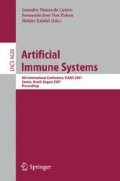Abstract
Many electronic systems would benefit from the inclusion of self-regulatory mechanisms. We strive to build systems that can predict, or be aware of, imminent threats upon their specified operation. Then, based on this prediction, the system can alter its operation or configuration to circumvent the effects of the threat. In this position paper, we discuss the role of the immune system can play in serving as inspiration for the development of homeostatic engineered systems, through the development of an immune inspired extensible architecture. We outline the major requirements for such an architecture, and discuss issues that arise as a result and propose possible solutions: things are never as simple as they first appear.
Access this chapter
Tax calculation will be finalised at checkout
Purchases are for personal use only
Preview
Unable to display preview. Download preview PDF.
References
Cannon, W.B.: The Wisdom of the Body. Norton, New York (1932)
Widmaier, E.P., Raff, H., Strang, K.T.: Vander’s Human Physiology: The Mechanisms of Body Function, 10th edn. Mc-Graw Hill, New York (2006)
Besedovsky, H.O., Del Rey, A.: Introduction: immune-neuroendocrine network. Front. Horm. Res. 29, 1–14 (2002)
Somayaji, A., Forrest, S.: Automated Response Using System-Call Delays. In: 9th USENIX Security Symposium (2000)
Brooks, R.: A Robust Layered Control System for a Mobile Robot. IEEE Journal of Robotics and Automation 2(1), 14–23 (1986)
Neal, M., Timmis, J.: Timidity: A Useful Mechanism for Robot Control? Informatica 27(4), 197–204 (2003)
Cohen, I.R.: Tending Adams Garden: Evolving the Cognitive Immune Self. Elsevier Academic Press, Amsterdam (2000)
Grossman, Z., Paul, W.E.: Adaptive Cellular Interactions in the Immune System: The Tunable activation threshold and significane of subthreshold response. PNAS 89, 10365–10369 (1992)
Grossman, Z.: Cellular Tolerance as a Dynamic State of the Adaptable Lymphocyte. Immunological Reviews. No. 133 (1993)
Grossman, Z., Paul, W.E.: Autoreactivity, dynamic tuning and selectivity. Current Opinion in Immunology 13, 687–698 (2001)
Matzinger, P.: The Danger Model: A renewed sense of Self. Science 296, 301–305 (2002)
Hershberg, U., Solomon, S., Cohen, I.: What is the basis of the immune system’s specificity? Mathematical Modelling and Computing in Biology and Medicine, 377–384 (2003)
Stepney, S., Smith, R.E., Timmis, J., Tyrrell, A.M., Neal, M.J., Hone, A.: Conceptual Frameworks for Artificial Immune Systems. Int. J. Unconventional Computing 1(3), 315–338 (2005)
Hone, A., van den Berg, H.: Modelling a Cytokine Network. In: FOCI 2007 (2007)
Andrews, P.S., Timmis, J.: A computational model of degeneracy in a lymph node. In: Bersini, H., Carneiro, J. (eds.) ICARIS 2006. LNCS, vol. 4163, pp. 164–177. Springer, Heidelberg (2005)
Mendao, M., Timmis, J., Andrews, P.S., Davies, M.: The Immune System in Pieces: Computational Lessons from Degeneracy in the Immune System. In: FOCI 2007 (2007)
Burns, A., Hayes, I.J., Baxter, G., Fidge, C.J.: Modelling Temporal Behaviour in Complex Socio-Technical Systems. Techinical Report YCS-2205-390. Department of Computer Science, University of York (2005)
Weeks, A., Stepney, S., Polack, F.A.C.: Neutral Emergence: a proposal. In: Symposium on Complex Systems Engineering, RAND Corporation (2007)
Tononi, G., Sporns, O., Edelman, G.M.: Measures of Degeneracy and Redundancy in Biological Networks. PNAS 96, 3257–3262 (1999)
Edelman, G.M., Gally, J.A.: Degeneracy and complexity in biological systems. PNAS 98(24), 13763–13768 (2001)
Author information
Authors and Affiliations
Editor information
Rights and permissions
Copyright information
© 2007 Springer-Verlag Berlin Heidelberg
About this paper
Cite this paper
Owens, N.D., Timmis, J., Greensted, A.J., Tyrell, A.M. (2007). On Immune Inspired Homeostasis for Electronic Systems. In: de Castro, L.N., Von Zuben, F.J., Knidel, H. (eds) Artificial Immune Systems. ICARIS 2007. Lecture Notes in Computer Science, vol 4628. Springer, Berlin, Heidelberg. https://doi.org/10.1007/978-3-540-73922-7_19
Download citation
DOI: https://doi.org/10.1007/978-3-540-73922-7_19
Publisher Name: Springer, Berlin, Heidelberg
Print ISBN: 978-3-540-73921-0
Online ISBN: 978-3-540-73922-7
eBook Packages: Computer ScienceComputer Science (R0)

